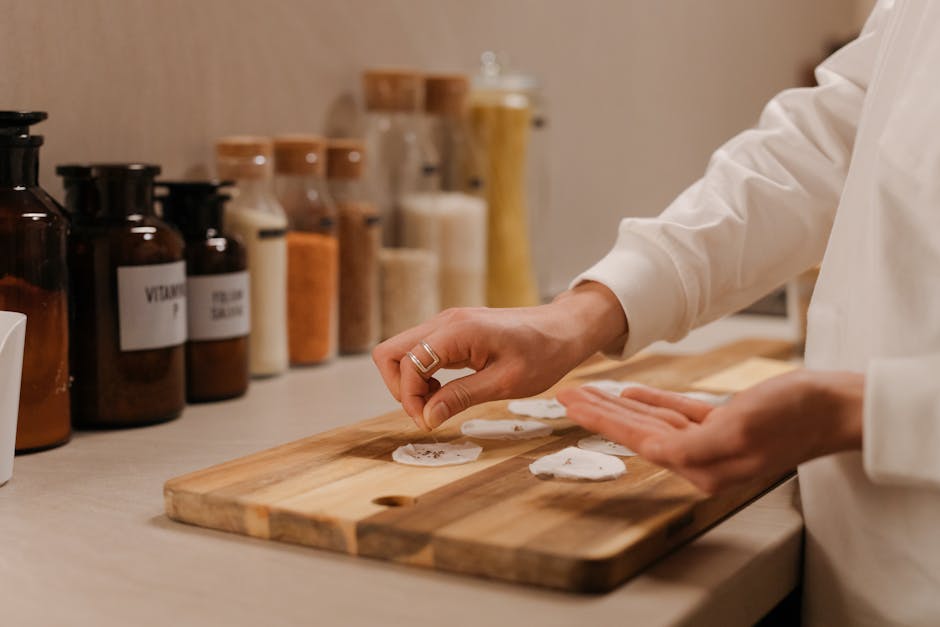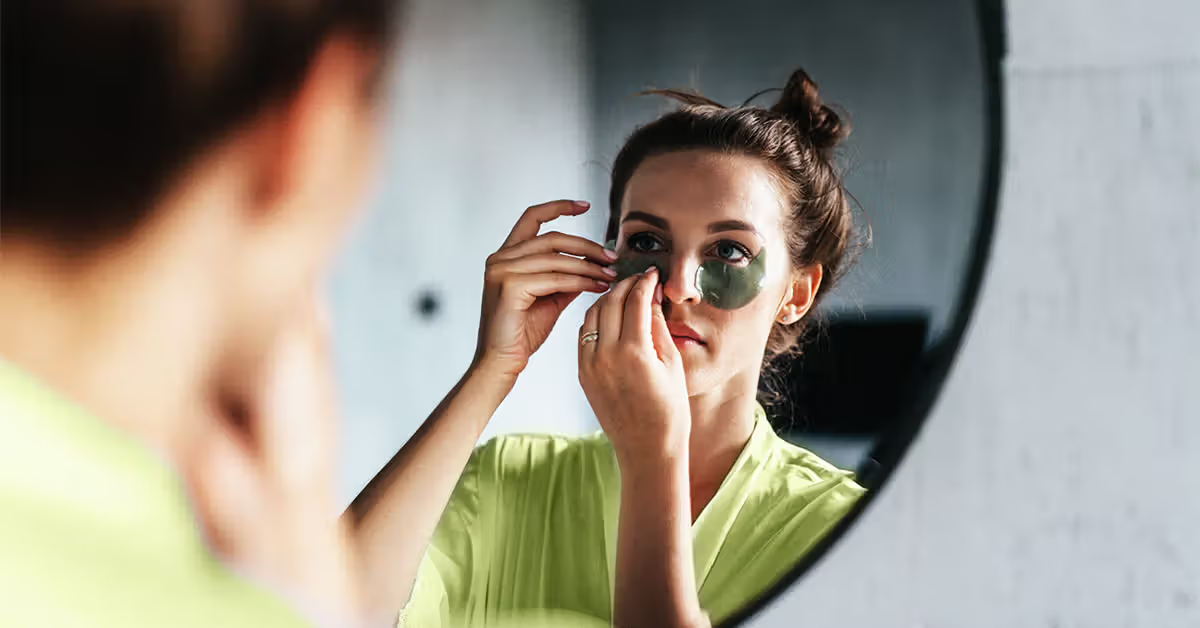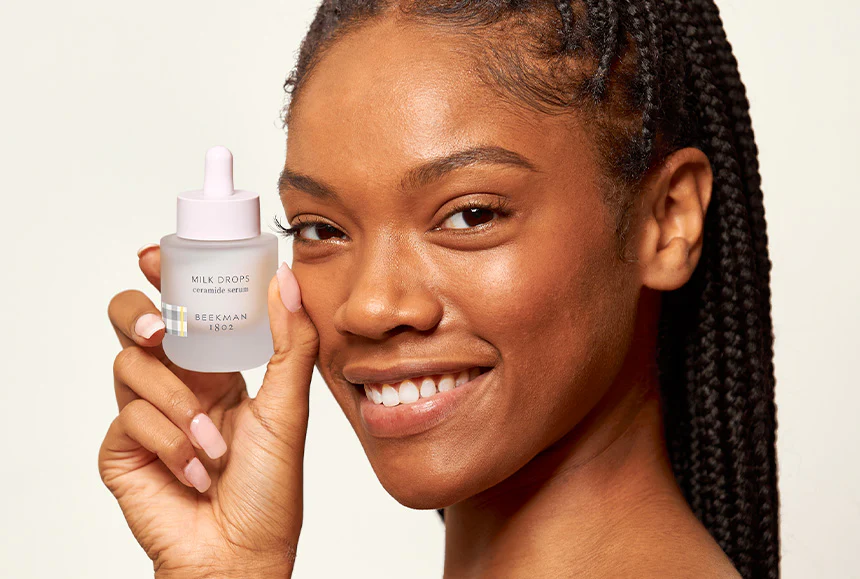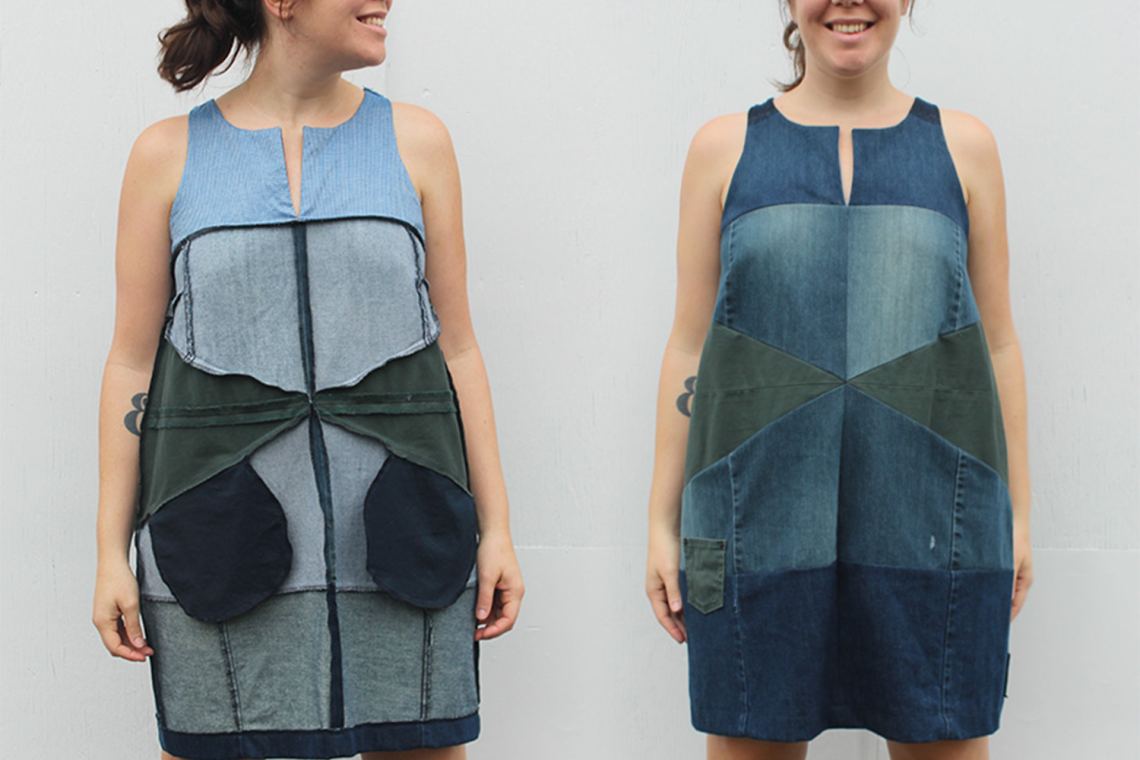The Natural Laboratory: DIY Skincare Ingredients Demystified
Looking for the most effective DIY skincare ingredients for homemade beauty products? Here’s a quick guide to the best options by category:
| Ingredient Type | Best for Dry Skin | Best for Oily Skin | Best for Sensitive Skin |
|---|---|---|---|
| Humectants | Hyaluronic acid, glycerin | Aloe vera, honey | Glycerin, oat extract |
| Oils | Argan oil, rosehip oil | Jojoba oil, grapeseed oil | Sunflower oil, squalane |
| Actives | Vitamin E, ceramides | Niacinamide, salicylic acid | Panthenol, bisabolol |
| Clays/Exfoliants | Kaolin clay (gentle) | Bentonite clay, AHAs | Colloidal oatmeal |
| Botanical Extracts | Chamomile, calendula | Green tea, witch hazel | Centella asiatica, licorice |
Creating your own skincare products has become more than just a trend—it’s a movement toward transparency, customization, and sustainability. DIY skincare ingredients allow you to take control of what goes onto your skin, avoiding harmful additives while targeting your specific concerns.
The beauty of DIY formulation lies in its accessibility. With just a few high-quality ingredients, you can create effective products that rival expensive commercial alternatives. As Marie, an experienced DIY formulator notes: “Just because something is delicious in a cake doesn’t mean it’s effective—or even safe—when it comes to skincare.” This wisdom reminds us that successful DIY skincare requires understanding ingredients, not just mixing random kitchen staples.
Whether you’re looking to hydrate dry skin with hyaluronic acid, control oil with clay masks, or soothe sensitivity with colloidal oatmeal, DIY skincare offers solutions for every skin type and concern. The key is knowing which ingredients work together and which should never meet your skin.
In this guide, we’ll explore the science behind effective DIY formulations, the must-have ingredients for your natural beauty lab, and how to avoid common mistakes that could harm your skin’s health.

Understanding Your Skin & Ingredient Selection
Before diving into the exciting world of DIY skincare ingredients, let’s talk about something really important – your unique skin. Think of your skin like your favorite outfit. Just as you wouldn’t wear a wool sweater to the beach, your skin needs ingredients that match its specific needs and temperament.
Know Your Skin Type
I remember when I first started making my own skincare products – I grabbed whatever ingredients sounded fancy without considering if they were right for my skin type. Big mistake! Your skin has its own personality:
Dry skin feels tight after washing and might flake or look dull. It’s basically thirsty skin that needs a drink of moisture.
Oily skin is that friend who’s always a bit too shiny in photos. Your face produces excess oil, especially in the T-zone, and your pores might appear larger.
Combination skin is playing both sides – oily in some places (usually forehead, nose, and chin) while dry in others (like the cheeks).
Sensitive skin reacts to products like a drama queen – getting red, irritated, or stingy when it doesn’t like something.
“The skin is the largest organ of the body with multiple protective and sensory functions,” explains dermatology research. By understanding your skin’s baseline, you can become its best friend rather than its irritating neighbor.
The Importance of pH Balance
Our skin naturally maintains a slightly acidic pH of about 4.5-5.5. This acidity is like your skin’s security system against bacteria and environmental damage. Many DIY skincare ingredients can throw this balance out of whack:
Ingredients that are too alkaline (like baking soda with pH ~9) can damage your skin barrier, leaving it vulnerable and irritated.
Super acidic ingredients (like straight lemon juice with pH ~2) can actually burn your skin – ouch!
For your DIY creations, aim for products with a pH similar to your skin’s natural level. Picking up some inexpensive pH testing strips can be a game-changer for safer formulations.
The Comedogenic Scale: Friend or Foe?
When I first heard about the comedogenic scale, I thought I’d found the holy grail for choosing oils. This scale rates ingredients from 0-5 based on their likelihood to clog pores:
0: Won’t clog pores (like squalane or argan oil)
1-2: Low chance of pore-clogging (hemp seed oil, sunflower oil)
3: Middle-of-the-road risk (sweet almond oil)
4-5: High likelihood of clogging (coconut oil, cocoa butter)
But here’s the reality check – this scale is just a guideline. As one DIY enthusiast shared: “I spent hundreds of dollars on carrier oils before realizing hydration was key.” Your skin might love an oil that’s supposedly pore-clogging, or break out from one that’s rated “safe.” Your skin is unique, which brings us to…
Patch Testing: Non-Negotiable Safety Step
This is your most important takeaway: always patch test new formulations. Always. I can’t tell you how many DIY disasters could have been avoided with this simple step:
- Apply a small amount of your creation to your inner forearm or behind your ear
- Cover with a bandage and wait 24-48 hours
- Check for any signs your skin is unhappy (redness, bumps, itching)
This quick check can save you from turning your entire face into a science experiment gone wrong, especially when working with potent DIY skincare ingredients like essential oils or active exfoliants.

Matching DIY skincare ingredients to dry skin
Dry skin is like a plant that needs watering – it’s thirsty for ingredients that replenish moisture and strengthen its protective barrier.
Shea butter is a superstar for dry skin – rich in fatty acids and vitamins that provide deep moisturization. A 2020 review noted that shea butter “softens skin, prevents water loss, has antiseptic properties, provides a barrier and supplies vitamin A.” It’s like a cozy blanket for parched skin.
Ceramides are naturally occurring lipids in your skin that help hold cells together, forming a protective layer that retains moisture. Think of them as the mortar between bricks in your skin barrier. Plant-derived ceramides can be wonderful additions to DIY formulations.
Hyaluronic acid is the moisture magnet of the skincare world, holding up to 1000 times its weight in water. It draws hydration into the skin without feeling heavy or greasy.
Rosehip oil delivers vitamins A and C directly to your skin, nourishing it while supporting cell turnover. The best part? It absorbs beautifully without leaving you looking like you’ve been dipped in oil.
Oat extract and colloidal oatmeal are gentle heroes that soothe irritation while locking in moisture. They’re perfect for dry skin that’s also on the sensitive side.
Matching DIY skincare ingredients to oily/combination skin
If you have oily or combination skin, you need ingredients that balance oil production without stripping your skin and triggering even more oil production.
Clays like bentonite and kaolin are natural oil absorbers. They draw out impurities while soaking up excess sebum. One user shared this success story: “Three sea salt and clay baths flattened bumps and cleared body imperfections after just three sessions.”
Niacinamide (vitamin B3) is that friend who knows how to calm everyone down at a party. It regulates sebum production and strengthens your skin barrier, making it perfect for oily skin formulations.
Lightweight oils might seem counterintuitive, but certain oils can actually benefit oily skin. Jojoba oil closely resembles your skin’s natural sebum, potentially “tricking” it into producing less oil. Grapeseed oil is another non-comedogenic option that hydrates without heaviness.
Salicylic acid (BHA) is oil-soluble, meaning it can actually penetrate into oily pores to clear out excess sebum and dead skin cells. One DIY formulator shared: “My propylene glycol-based vitamin C and salicylic acid serum reduced my need for blotting papers dramatically.”
Witch hazel works as a natural astringent that temporarily tightens pores and removes excess oil. Just use it sparingly – overuse can actually trigger more oil production.
Matching DIY skincare ingredients to sensitive skin
Sensitive skin requires a gentle approach – think of it as the friend who needs extra care and consideration.
Aloe vera is nature’s soother with anti-inflammatory and cooling properties. Fresh from the plant or as a high-quality gel, it calms irritation almost immediately.
Colloidal oatmeal isn’t just for breakfast – studies show its anti-inflammatory properties make it ideal for sensitive, reactive skin. It forms a protective barrier while reducing redness and irritation.
Bisabolol, derived from chamomile, calms irritation and reduces redness. It’s like a gentle whisper telling your skin to relax.
Centella asiatica (Cica) has been used for centuries in traditional medicine. This herb promotes wound healing and soothes irritated skin with its anti-inflammatory compounds.
Fragrance-free formulations are often best for truly sensitive skin. While essential oils smell lovely, they’re common triggers for reactive skin. A 2018 study found that “nature-based products were superior in managing sensitive skin compared to synthetic formulations,” but simplicity is key – fewer ingredients often means fewer potential reactions.
Creating effective DIY skincare is about understanding your skin first, then choosing ingredients that address its specific needs. Your skin is unique – learning to listen to what it’s telling you is the first step toward creating truly effective homemade skincare.
Powerhouse DIY Skincare Ingredients to Accept
Now that we understand how to match ingredients to skin types, let’s explore the most effective DIY skincare ingredients by category. These powerhouse components can transform your homemade formulations from basic to professional-grade.
Humectants that plump: Hyaluronic Acid & Glycerin—star DIY skincare ingredients
When it comes to hydration, humectants are your skin’s best friends. These moisture-loving ingredients draw water into your skin, creating that coveted plump, dewy effect we all crave.
Hyaluronic Acid (HA) is truly a hydration superstar. Naturally found in our skin, this remarkable molecule can hold up to 1000 times its weight in water! As we get older, our natural HA levels start to decline (isn’t aging fun?), which is why adding it to your DIY skincare ingredients arsenal makes so much sense.
When working with HA in your homemade creations, opt for low molecular weight versions for deeper skin penetration. Always pair it with an occlusive ingredient to seal in all that wonderful moisture—otherwise, the water it attracts might evaporate and leave your skin drier than before! Store your HA products in dark, airtight containers to keep them fresh and effective.
Glycerin is another hydration hero that deserves a spot in your DIY toolkit. This affordable, versatile humectant creates a protective layer on your skin while drawing in moisture. I like to think of glycerin as that reliable friend who always shows up when needed—it works beautifully at a 3-5% concentration in virtually any water-based DIY product without feeling sticky.
As Marie wisely points out, “Oils and butters are gorgeous, but they cannot—by definition—hydrate.” This highlights why humectants like HA and glycerin are absolutely essential in any effective skincare routine, regardless of your skin type.
Peptides, Niacinamide & CoQ10—targeted DIY skincare ingredients for anti-aging
If you’re looking to address signs of aging in your DIY formulations, these active ingredients deserve your attention.
Peptides are tiny protein fragments that work like messengers, signaling your skin cells to produce more collagen and boost repair processes. While once found only in expensive department store brands, peptide complexes are now available to home formulators like us! Add them to water-based serums at the recommended concentration (usually 2-10%) and store in cool, dark places to maintain their potency.
Niacinamide (Vitamin B3) is truly the multitasking miracle worker of DIY skincare ingredients. It strengthens your skin barrier, smooths fine lines, evens out skin tone, and helps regulate oil production—all in one ingredient! For best results, use it at 2-5% concentration, making sure to dissolve it completely in your water phase before adding other ingredients. Just remember to keep it separate from acidic ingredients, as they don’t play well together in the same formula.
Coenzyme Q10 (CoQ10) is a powerful antioxidant that naturally decreases in our skin as we age. Adding this to your DIY products helps protect against environmental damage and supports your skin cells’ energy production. The oil-soluble version works beautifully in anhydrous (water-free) formulations at 0.5-1%, especially when paired with vitamin E for improved antioxidant protection.
Oils, Butters & Waxes 101
The lipid-based category of DIY skincare ingredients provides essential moisture, protection, and texture to your homemade creations.
Each carrier oil brings something special to the table through its unique fatty acid profile. Jojoba oil is actually a liquid wax ester that closely resembles our natural sebum, making it suitable for virtually all skin types. Argan oil delivers lightweight moisture packed with vitamin E and essential fatty acids. Rosehip oil, rich in vitamins A and C, supports cell regeneration for a brighter complexion. For those with acne-prone skin, grapeseed oil offers a lightweight texture high in beneficial linoleic acid.
Butters add rich moisture and protective qualities to your DIY products. Shea butter stands as the most versatile option with its anti-inflammatory properties and skin-loving nutrients. Mango butter offers a lighter feel that absorbs quickly without excessive greasiness. Cocoa butter provides intensive protection with its distinctive chocolate scent (though unrefined versions might make you crave brownies while moisturizing!). Kokum butter has a firmer texture that helps stabilize your formulations while providing excellent emollient properties.
Waxes give structure and staying power to your DIY creations. Beeswax not only creates a protective barrier but also acts as a natural humectant. As one formulator notes, “Beeswax not only hydrates but also waterproofs homemade formulations,” making it perfect for lip balms and salves. For vegan alternatives, candelilla wax and carnauba wax offer plant-based options that increase product stability and add a beautiful shine.
Clays, AHAs & BHAs for clarifying routines
When your skin needs a deep clean or gentle exfoliation, these DIY skincare ingredients deliver impressive results.
Clays offer natural detoxification and oil control. Bentonite clay stands out with its highly absorbent properties and negative electrical charge that helps draw out positively charged toxins. For those with sensitive or dry skin, kaolin clay provides a gentler alternative that cleanses without stripping. French green clay balances with moderate oil-absorbing abilities and mineral richness, while rhassoul clay cleanses effectively without over-drying.
Alpha Hydroxy Acids (AHAs) work by dissolving the bonds between dead skin cells, revealing fresher skin underneath. Glycolic acid, with its tiny molecule size, penetrates deeply for effective exfoliation. Lactic acid offers a gentler approach with bonus hydrating properties, making it ideal for sensitive skin types. Mandelic acid, with its larger molecule size, provides the gentlest AHA experience while still delivering noticeable results.
The star Beta Hydroxy Acid (BHA) is salicylic acid, which, unlike water-soluble AHAs, can cut through oil to clear out clogged pores. As one skincare expert notes, “In general, no, a homemade scrub is not a substitute for a salicylic acid/BHA scrub,” highlighting the unique benefits of properly formulated chemical exfoliants over physical scrubs.
For a natural approach to chemical exfoliation, enzyme exfoliants like papain from papaya and bromelain from pineapple gently dissolve dead skin cells without harsh scrubbing. You can create a simple enzyme mask by blending unripe pineapple and papaya into a pulp, applying it to your face and neck for 10-15 minutes before rinsing off. Used 2-3 times weekly, this natural treatment can reveal brighter, smoother skin over time.
When formulating with these powerful DIY skincare ingredients, gentler is often better. Start with lower concentrations and less frequent application until you see how your skin responds to these active ingredients.
Ingredients to Avoid & Common DIY Mistakes
While DIY skincare can be rewarding, certain ingredients and practices can do more harm than good. Let’s explore what to avoid in your natural beauty laboratory.

High-risk “natural” DIY skincare ingredients
That “all-natural” label might sound appealing, but Mother Nature isn’t always gentle on your skin. I’ve seen too many Pinterest fails turn into painful skin lessons!
Baking soda seems harmless enough for cookies, but on your face? It’s a disaster waiting to happen. With a pH around 9, it’s far too alkaline for your skin’s natural 4.5-5.5 pH level. This disrupts your protective barrier, leaving you with irritation and redness that can take weeks to heal.
One reader shared her painful experience: “I tried that DIY deodorant with baking soda everyone raved about. Two days later, my underarms were covered in a burning rash. Turns out high pH and sensitive skin don’t mix!”
Lemon juice is another kitchen staple that should stay in your salad dressing. Its extremely acidic nature (pH around 2) can cause chemical burns, especially if you go outside afterward. The phototoxic reaction can lead to blistering and hyperpigmentation that lasts for months.
As dermatologists have documented in research on lemon juice risks: “Citrus juice can cause phytophotodermatitis—a UV-triggered burn that may blister and create dark spots lasting months.”
Cinnamon might make your cookies smell divine, but on your skin? It’s a recipe for disaster. This spice is a known irritant that can cause severe contact dermatitis and actual burns. Just ask beauty blogger EnjoyPhoenix, whose cinnamon mask experiment led to painful facial burns that her followers witnessed in real-time.
Undiluted apple cider vinegar has beneficial properties when properly diluted (think 1 part ACV to 3-4 parts water), but using it straight from the bottle can corrode your skin barrier and cause burns that take weeks to heal.
The “kitchen sink” syndrome
I call it the “more is more” mistake. You’ve bought all these amazing DIY skincare ingredients, so why not use them all at once? Trust me, I’ve been there!
This approach creates several problems:
First, many ingredients simply don’t play well together. Niacinamide and vitamin C can neutralize each other. Certain oils and water-based ingredients separate without proper emulsifiers. When your beautiful creation separates into an oily mess overnight, that’s ingredient incompatibility at work.
Second, when your skin reacts negatively (and it likely will), you’ll have no idea which ingredient caused the problem. Was it the essential oil? The botanical extract? The acid? Without this knowledge, you’re stuck in a frustrating cycle of trial and error.
As one experienced formulator told me: “Overloading a DIY formula with too many actives prevents understanding which ingredient actually delivers results. Start simple, then build complexity as you learn.”
“Just because something is delicious in a cake doesn’t mean it’s effective—or even safe—when it comes to skincare.” — Marie
High-risk “natural” DIY skincare ingredients
Let’s talk about the truly questionable DIY trends that occasionally make the rounds on social media.
Egg whites might seem like a simple firming mask, but beyond the unpleasant smell when they dry, raw eggs can carry Salmonella bacteria. Do you really want to risk a skin or eye infection for a temporary tightening effect?
Then there’s the truly bizarre trend of using bodily fluids in skincare. Yes, I’m talking about urine facials, breast milk serums, and even (brace yourself) semen as a skincare ingredient. Despite what TikTok might suggest, these substances offer no proven benefits and come with significant contamination risks.
Board-certified dermatologist Dr. Yoram Harth puts it bluntly regarding semen facials: “Looking at the semen ingredients, there is nothing that can help with acne for the long-term. The proteolytic enzyme may, in theory, cause some exfoliation of the skin, but this effect would be minimal and insignificant.”
Raw citrus placed directly on skin isn’t just irritating—it can cause chemical burns and trigger photosensitivity reactions that lead to blistering and hyperpigmentation when exposed to sunlight.
The “kitchen sink” syndrome
The best approach to DIY skincare is actually minimalism. Start with simple, proven formulations using just a few quality DIY skincare ingredients. Document your skin’s response, then gradually introduce new ingredients one at a time.
This methodical approach helps you find which ingredients truly benefit your skin and which might be causing irritation. It also leads to more stable formulations that don’t separate or spoil quickly.
When troubleshooting problems, a simpler formula makes it much easier to identify the culprit. Was your skin fine with the base lotion but reacted when you added lavender essential oil? That’s valuable information you wouldn’t have if you’d included ten different botanicals at once.
Commercial skincare products undergo extensive stability and compatibility testing—something we can’t replicate at home. By keeping your formulations straightforward, you’re giving your DIY creations the best chance of success.
The bottom line? Quality trumps quantity every time when it comes to DIY skincare ingredients. Your skin will thank you for your restraint!
Safe Formulation, Preservation & Equipment Essentials
Creating effective and safe DIY skincare isn’t just about mixing ingredients together—it’s about approaching formulation with the precision of a scientist and the creativity of an artist. Let’s explore what you’ll need to transform your kitchen into a natural beauty laboratory that produces safe, effective products.
Preservation: Non-Negotiable for Water-Based Formulations
I can’t stress this enough: any DIY skincare ingredients that include water require preservation. This isn’t optional or just for “shelf stability”—it’s about preventing potentially harmful microorganisms from growing in your beautiful creations.
One of the most heartbreaking moments for new DIY formulators is finding fuzzy mold growing in their lovingly crafted face cream. As one home formulator shared with me, “Making unpreserved creams that later turned moldy was both disappointing and eye-opening. I learned that preservation isn’t about chemicals—it’s about safety.”
Water creates the perfect environment for bacteria, yeast, and mold to thrive, often within days, even when refrigerated. For safe formulations, consider these preservative options:
Leucidal Liquid offers a probiotic-based approach that’s effective against both bacteria and fungi, making it popular among natural formulators. Optiphen provides paraben-free protection with excellent compatibility across formulations. If you’re looking for reliability, Germall Plus delivers consistent broad-spectrum coverage, while Preservative Eco appeals to those seeking a natural preservation system.
Most preservatives work effectively at just 0.5-1% of your total formulation weight—a small amount that delivers significant protection. Always follow your supplier’s specific guidelines for usage rates, pH requirements, and temperature limitations.
Emulsification: The Science of Mixing Water and Oil
Have you ever shaken a bottle of salad dressing, only to watch the oil and vinegar separate moments later? The same principle applies to skincare—without an emulsifier, your water and oil ingredients will separate, leaving you with an unstable product.
Creating stable emulsions requires attention to detail:
The temperature matters tremendously—most emulsification happens at 70-75°C (158-167°F), where both phases become more willing to combine. Your mixing technique is equally important; high-shear mixing with a mini mixer or stick blender helps create the tiny droplets needed for a stable emulsion. And order matters too—typically adding your oil phase to your water phase while mixing yields the best results.
For beginners, Emulsifying Wax NF offers reliability and forgiveness. If you prefer plant-derived options, Olivem 1000 provides olive-derived emulsification with skin-friendly properties. Professional formulators often reach for Polawax for its exceptional stability, while Lecithin serves as a natural option for simpler formulations.
Essential Equipment for DIY Skincare Success
Your DIY skincare ingredients deserve proper tools. Think of these items as investments that will lift your creations from kitchen experiments to professional-quality products:
Precision is non-negotiable when working with potent ingredients. A digital scale accurate to 0.01g ensures you’re adding exactly what your formula requires—especially important for preservatives and active ingredients. A pH meter or strips helps you confirm your creation falls within the skin-friendly range of 4.5-5.5, while a reliable thermometer ensures your heating and cooling phases hit the right temperatures for proper emulsification.
For mixing, a mini mixer or frother creates smoother emulsions than hand-stirring ever could. Glass mixing bowls resist heat and won’t react with your ingredients, and silicone spatulas help you capture every precious drop of your creation.
Don’t overlook sterilization—contamination can ruin even the most perfectly formulated product. Keep 70% isopropyl alcohol on hand for sanitizing surfaces and containers, use distilled water rather than tap water for your formulations, and protect your hands with heat-resistant gloves when handling hot ingredients.
For storage, amber glass bottles protect light-sensitive ingredients from degradation, airless pump bottles minimize contamination during use, and PET plastic jars provide a lightweight alternative to glass for products like body butters.
As one experienced formulator reminds us, “Sanitize containers before each new batch—it takes just minutes but can save your entire product.”
Step-by-step basic lotion formula
Ready to try your hand at creating a simple yet effective lotion? This formula serves as an excellent starting point that you can later customize to your heart’s content:
Water Phase (70%):
- 68.5% Distilled water
- 1.5% Glycerin
Oil Phase (25%):
- 15% Light carrier oil (sweet almond or grapeseed work beautifully)
- 8% Shea butter
- 2% Cetyl alcohol (improves texture and stability)
Emulsifier (5%):
- 5% Emulsifying wax
Cool-Down Phase (added below 40°C/104°F):
- 0.5% Preservative
- Optional: 0.5-1% essential oils or fragrance (reduce water accordingly)
The process is straightforward but requires attention to detail. Begin by sanitizing all your equipment and containers with alcohol. Weigh your water phase ingredients in one heat-resistant glass container and your oil phase ingredients in another. Heat both phases to 70°C (158°F)—this temperature is crucial for proper emulsification.
With both phases at the right temperature, slowly pour your oil phase into your water phase while mixing continuously. Continue mixing for 3-5 minutes to ensure everything incorporates properly. Allow your emulsion to cool to 40°C (104°F), mixing occasionally to maintain consistency. At this temperature, add your cool-down phase ingredients, including preservative and any heat-sensitive actives.
Finally, pour your creation into sanitized containers and label with the date and ingredients list—future you will appreciate knowing exactly what’s in that bottle six months from now!
Storage & shelf-life hacks
Even the most perfectly preserved formulations benefit from proper storage techniques. These simple hacks can significantly extend the life of your DIY creations:
Dark containers make a dramatic difference—amber or cobalt glass protects light-sensitive ingredients from degradation. For even better protection, consider airless packaging that minimizes oxidation and contamination each time you use your product.
Refrigeration is your friend, especially for natural formulations. The cooler temperature slows microbial growth and oxidation processes. Adding natural antioxidants like Vitamin E (0.5-1%) helps prevent oils from going rancid, extending shelf life significantly.
Develop the habit of batch coding—simply labeling with the creation date and ingredients list helps you track how long products last and which formulations perform best over time.
Different formulations have different shelf lives. Anhydrous (water-free) products like body butters and oil serums typically last 6-12 months. Properly preserved water-based products should remain good for 3-6 months, while unpreserved water-based products should be used within 1-2 weeks, even when refrigerated.
One particularly wise piece of advice for working with unstable ingredients: “Make small batches of vitamin C serum to minimize oxidation.” This approach ensures you’re always using fresh, potent product rather than degraded ingredients.
Before each use, perform a quick sensory check—if your DIY product has changed color, texture, or smell, it’s time to say goodbye. No product, no matter how lovingly crafted, is worth risking skin irritation or infection.
With these foundational techniques and tools, you’re well-equipped to create safe, effective skincare that rivals commercial products—without the mystery ingredients or inflated price tags.
Frequently Asked Questions about DIY Skincare Ingredients
Are DIY skincare products cheaper and more effective than store-bought?
The million-dollar question! (Or perhaps I should say the “save-a-million-dollars” question?) When it comes to cost-effectiveness, the truth falls somewhere in the middle.
Making your own products can absolutely save you money, especially when you stick to simpler formulations. That facial oil that costs $45 at the fancy boutique? You might create something similar for under $10 using a few quality carrier oils. Many DIY skincare ingredients like shea butter, glycerin, and aloe vera are surprisingly affordable when purchased in bulk.
However, the savings aren’t guaranteed in every situation. As one of our community members shared: “It can be cheaper when using simple, natural, readily available ingredients, but costs may exceed ready-made products if you use expensive extracts or waste perishable batches.”
The initial investment in equipment (scales, containers, pH meters) can add up. And if you’re eyeing advanced ingredients like specialized peptide complexes or stabilized vitamin C, you might actually spend more per ounce than buying a commercial product that benefits from economies of scale.
As for effectiveness? Well-crafted DIY products can work wonderfully, especially when custom to your specific skin concerns. The freshness factor can’t be beaten—your homemade vitamin C serum might actually deliver more active ingredient than a store-bought version that’s been sitting on a shelf for months. Plus, you control every ingredient, avoiding potential irritants or allergens.
That said, commercial products do have access to certain delivery systems, stabilization technologies, and patented ingredients that are difficult to replicate in your kitchen laboratory.
How do I safely patch-test new DIY skincare ingredients?
Patch testing isn’t just recommended—it’s essential when working with new DIY skincare ingredients. Even natural ingredients can cause reactions in sensitive individuals.
The gold-standard approach is the 24-48 hour patch test:
- Apply a small amount of your ingredient or finished product to your inner forearm
- Cover with a small bandage to prevent it from rubbing off
- Leave in place for at least 24 hours (48 is better for thorough testing)
- Watch for any warning signs: redness, itching, burning sensation, or rash
- If your arm passes the test, try a tiny amount behind your ear for facial products
- Wait another day before applying to your entire face
“Perform a 24-48-hour patch test on your inner wrist or elbow to check for allergic reactions,” advises a dermatologist I consulted with. “Many people skip this step and regret it later.”
For ingredients with potential photosensitivity concerns (like certain citrus essential oils), make sure to test on an area that can be safely exposed to a bit of sunlight. This helps identify any UV-triggered reactions before you apply the product more widely.
Remember: just because an ingredient is natural doesn’t mean it’s automatically safe for your unique skin. Patch testing takes patience but can save you from a full-face reaction!
Can I add advanced actives like peptides and vitamin C at home?
Yes, you can work with sophisticated DIY skincare ingredients like peptides and vitamin C at home—but they require special handling and understanding. Let’s break down the considerations for popular advanced actives:
Vitamin C (L-Ascorbic Acid) can be wonderfully effective in concentrations of 10-20%, but it’s notoriously unstable. It needs a pH of 3.0-3.5 to penetrate skin effectively, oxidizes quickly when exposed to air and light, and can be irritating at higher concentrations.
Your best DIY approach? Make small, fresh batches weekly in dark amber bottles, store them in the refrigerator, and watch for color changes (yellow or brown means it’s oxidized). “Commercial vitamin C serums can cost over $100 for stable, high-concentration formulations,” making the DIY approach appealing if you’re willing to make fresh batches regularly.
Peptides are another advanced ingredient that’s becoming more accessible to home formulators. These typically work best at concentrations between 2-10% (depending on the specific peptide) and prefer a neutral pH environment. The challenge is that they’re expensive and can be destabilized by certain ingredients or improper formulation techniques.
For best results, look for pre-formulated peptide complexes specifically designed for home formulators rather than trying to work with raw peptide powders.
Retinol and retinoids are powerful anti-aging ingredients that can be incorporated into DIY formulations, but they require careful handling. They’re extremely sensitive to light and air, and can cause significant irritation if used incorrectly. Beginners might want to start with gentler derivatives like retinyl palmitate at low concentrations (0.01-0.1%).
When working with any advanced active ingredients, thorough research is your best friend. Start with lower concentrations, be vigilant about pH testing when necessary, and pay special attention to proper storage conditions. Your skin will thank you for the extra care!
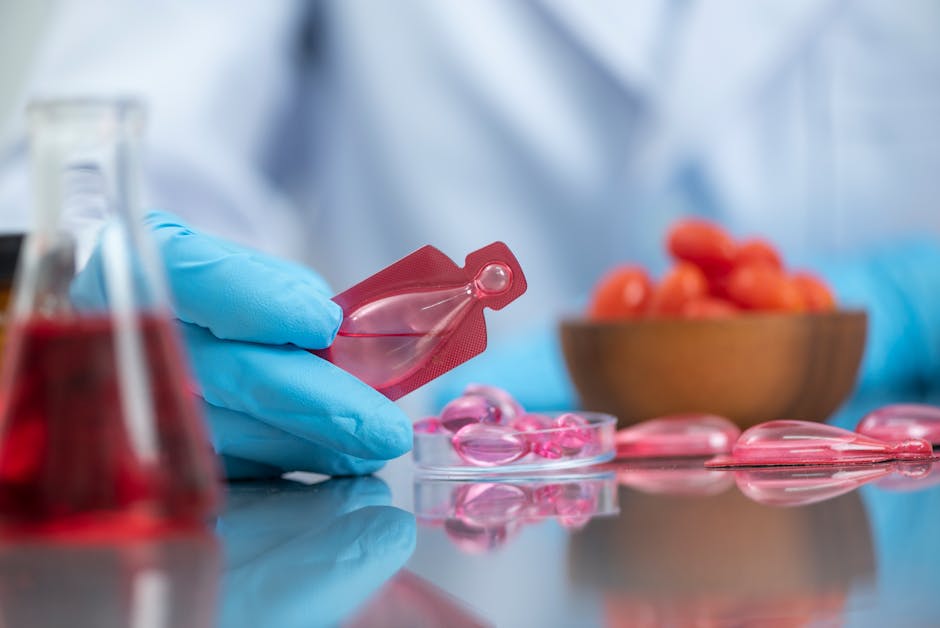
Conclusion
The journey into DIY skincare ingredients is like opening a door to a world where you create beauty products perfectly matched to your unique skin. There’s something deeply satisfying about mixing a face cream that addresses exactly what your skin needs – without any fillers or questionable additives.
Throughout this guide, we’ve explored the science, ingredients, and techniques that transform kitchen experiments into effective skincare. Let’s recap what we’ve learned on this DIY trip:
First and foremost, understanding your skin is the foundation of successful formulating. Just as you wouldn’t follow a recipe without considering your dietary needs, your skin deserves ingredients selected specifically for its type and concerns. This personalized approach is perhaps the greatest advantage of DIY skincare.
Quality truly matters when selecting ingredients. That bargain-bin oil might save a few dollars, but your skin deserves better. As we like to say at Beyond Beauty Lab, “Your skin will only be as good as what you feed it” – whether that’s through diet or topical application.
Safety isn’t just a suggestion – it’s non-negotiable. From proper preservation to patch testing, these steps protect your skin from potential harm. Remember Marie’s wise observation: “Just because something is delicious in a cake doesn’t mean it’s effective—or even safe—when it comes to skincare.” This simple truth should guide your ingredient selections.
For beginners, simplicity is your friend. Start with basic formulations before attempting that 12-ingredient anti-aging serum you found online. Your confidence and skills will grow with each successful creation, allowing you to gradually tackle more complex formulations.
Keep a formulation journal to track what works and what doesn’t. Note how your skin responds to different ingredients and combinations. This documentation becomes invaluable as you refine your personal skincare collection.
At Beyond Beauty Lab, we believe in the power of knowledge. Understanding ingredients empowers you to make informed choices – whether you’re creating products from scratch or evaluating store-bought options. The skills you develop in DIY formulation make you a more discerning consumer overall.
Ready to begin your DIY skincare journey? Start small with our basic lotion recipe, then gradually expand your ingredient collection as you gain confidence. Your bathroom shelf will soon showcase custom creations perfectly aligned with your skin’s needs – and you’ll likely save money in the process.
For deeper insights into clean beauty ingredients and carefully vetted product recommendations, explore our ingredient glossary and curated product guides.
Your skin is unique, and it deserves skincare that celebrates that individuality. Happy formulating – we can’t wait to see what you create!

